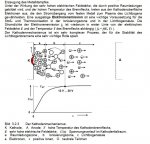mbrooke
Batteries Included
- Location
- United States
- Occupation
- Technician
Forgive the German- I can translate. But why are they showing electrons on what appears to be large positively charged particles?
Page 36:
https://www.studocu.com/de/document...n/andere/teil-1-vorlesungsskript/1821727/view
The cathode fall area (Figure 3.2.3) extends over a very short length of 0.1 ... 1 μm.
The cathode voltage case U
KF
is usually a few tens of volts and is very strong of
the ionization energy of the cathode material dependent (Table 3.2.2). Because the
Ionization energy of metal particles is significantly lower than that of gas particles, it will
in the ionization zone, primarily the metal vapor from the cathode is ionized. Then sweep
the positive ions and are greatly accelerated in the cathode fall area. They form completely
close to the cathode surface a positive space charge zone. You meet the
On cathode surface, release their kinetic and potential energy and form here below
Temperature increase a focal spot. For carbon electrodes occur in the focal spot
Temperatures between 3000 and 4000 K on, while metal electrodes 3000 K hardly
be crossed, be exceeded, be passed. Under the high temperature of the focal point is again the
Generation of metal vapor.
Under the effect of very high electric field strength caused by positive space charges
is formed, and the high temperature of the focal spot, emerge from the cathode surface
Electrons out the current transfer from the solid metal to the plasma of the arc
guarantee. An extensive electron emission is an important prerequisite for the
Shock and thermal ionization in the ionization zone and in the arc column. The
Current density of the electron emission j
e is in turn primarily of the electrical
Field strength E and the temperature T of the focal spot dependent {j
e = f (E, T)}.
The cathode mechanism is a very complex process that contributes to the stability of the
Arc burning plays a very important role.
Page 36:
https://www.studocu.com/de/document...n/andere/teil-1-vorlesungsskript/1821727/view


